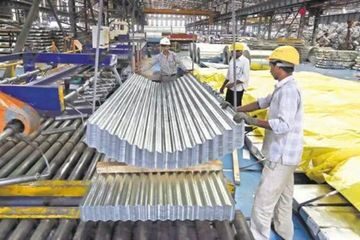Why debt is becoming death knell for Indian businesses
With the beginning of reforms in 90’s which spelled bull run in the stock markets, budding & existing entrepreneurs sensed the opportunity of nurturing their dreams of creating & expanding the businesses which made sense given the domestic demand & supply realities that time. Imports were still under heavy control however the risk of Imports was far less due to high duty overhang.
Industrial financing was mainly led by IFCI, IDBI & ICICI. They were treated as primary sponsors of industrial development and the thought of manufacturing venture would land any entrepreneur on the doors of these institutions. Of these IFCI was more liberal followed by IDBI. ICICI was relatively more choosy & selective. However, size of the projects & relative loan during the period would be moderate.
Interest rates during 90’s were relatively higher but at the same time operating margins in businesses were much higher than what followed latter in the years and as such business were able to absorb higher interest costs despite higher component of debt and lesser equity. After the global boom, which started in 2002 onwards, Indian banks came on the forefront of project financing and started to take active lead in financing. By then IFCI had already retreated, under the pain of slowly spreading bad debts. This pain was ignored as attributable to bad management decisions.
Indian banks became more and more aggressive in financing & competed to grab maximum business. There were compromises in quality and process for approval of loans. Their enthusiasm was well supported by healthy growth rates in domestic & international economy. Bank management would clamor to register 20% annual growth year on year basis. As a result of the annual growth targets & even achievements the loan assets of Indian banks swelled by 2012-13. Conversely the loan liabilities of corporate balance sheets also fattened beyond repair.
The problem of leverage or extensive leverage was always there but it was hidden due to continued refinancing of debt until the level of debt reached unsustainable levels & further refinancing stopped due to certain developments better to avoid here. The fundamental question is why is debt continuing to become incurable disease with the Indian balance sheets. Debt, interest rates & relative margins in business are the main plank articulated in this article.
The problem of leveraged is associated with
i. Higher interest rates
ii. Decreasing margins of profitability
iii. Lesser equity & Debt to equity unbalancing in balance sheets
Debt has always been convenient, preferred and go to route to finance any capital or working capital needs of corporates. Debt was relatively easily available from multiple sources & debt raising was also manageable even with inherent weakness in corporate balance sheets smoke screened by presentation of accounting & financial data to carry the proposals through. It’s admitted fact that the norms for debt raising were never stringent & process of due diligence lacked any credibility resulting in free flow of debt to balance sheets. Indian promoters have been historically very optimistic which they should but only to the extent of core businesses they promoted, they unfortunately expanded their vision to every faculty of business more particularly to financial management which eventually became weakness with majority of promoters AND professionals were equally responsible by silently toeing the line bringing in loads of debt which was unwarranted. Further, the major issue was that promoters were traditionally not inclined to dilute their stakes & aspired for sky-high valuations. Equity raising opportunities aren’t available round the clock. In a depressed equity markets equity raising is a challenge yet whenever markets offered that chance, it was rarely welcomed in expectation of better value matrix. Dilution of equity may be important issue but the safety of balance sheets is more critical which was never perceived a risk until risk crystallised into a doom. Equity is a costly source of funding but with a low risk compared with a high risk debt funding. If we look back to last 25 years of Indian corporate history, I would count the companies on fingers, which utilised every opportunity to tap money from equity markets. Lack of equity to replace debt in the balance sheets until it overflowed the cash accruals to drown the business away. There are many heart aching stories of corporate failures due to resistance to raise equity when opportunity was knocking the door but was turned away … eg Unitech, Bhushans, JP Group, Essar, & many of them. We need not to discuss where the companies or their promoters stand today. It’s one lesson that every finance professional should learn & every promoter to follow is respect the equity & let it come when it’s needed. There are acceptable ways of shoring up holdings, what is needed for the survival & continuity of control. Raising of resources Via equity should be considered even when money may not be needed but equity dilution is supported by performance of the company & keenness of investors. As a matter of fact balance sheets must carry sufficient levels of liquidity essentially in industries, which are governed by cyclicality. Equity raising can’t be timed but the time will provide the opportunity to raise equity & the time should be welcomed with respect.
Higher interest rates vs Decreased margins of profitably If we look at interest rates in India in the last 30 years, it gives us an interesting reading. In 90’s interest rates were very high but that was an era when inflation was also very high. The rates softened a bit in new century.
As per table produced below but we haven’t seen any downward trend in rates in last 20 years.
Interest rates in India haven’t softened & the above table suggests that the rates have remained elevated but the relative margins have softened. Interest rates in India can’t create a competitive landscape for Indian companies. Our interest rates are way above global levels but unfortunately inflation rates don’t provide room to policy makers to reduce rates substantially. Hence our interest rates have become subordinate to inflation & not aligned to changed realities of business facts. Therefore it has become all the more necessary to reduce the dependence on debt both for capex & general corporate requirements. Debt as a main source of funding is history in India, so if equity isn’t available adequately, it’s logical to reduce the size of asset deployment. Contraction of balance sheet is the only way to manage lesser debt levels given the accompanying shortage of equity. Indian managements must be ready to take the call before more stories of debt-laden groups like DHFL, Zee, ADAG are avoided.
Interest cost is the ability of the cash flows to absorb but this ability has gradually been eroding due to falling operating margins owing to integration of global economy and free flow of trade and business across borders over time necessitating contraction of debt in balance sheets. Margins of profitability or more appropriately operating profit margins have seen significant change across sectors. Operating margins were high even in first decade of this century (2001-2010), & much higher in 90’s but they have been coming down due to multiplicity of factors such as
- Increased supply & competition
- Free trade across borders
- Lesser growth in demand to supply
- Competition due to alternative products coming to markets
- Changes due to technological advancements
- Scalability of capacities by large players unseen in India earlier
If we study any business 20 years back & track the performance of industry, there are few similar developments across industries in terms gradual contraction in margins accompanied by product innovations, technological advancements, extended range of products. The shrinkage of operating margins is again influence of free market economy & stiff competitiveness healthy for consumers but could be unhealthy for businesses unless addressed appropriately by managements. Thus falling margins in businesses over time has shown the exit door to over leveraging more so in India where cost of debt is very high relative to other countries. The cumulative impact of multiple factors contracting the operating margins is fundamental to free market economy. However, ability of balance sheets to absorb debt ought to come down to realistic levels but that didn’t happen. In the current economic scenario the risk of carrying even normal level of debt have become very high. We have always trusted debt equity ratio but in my opinion this is a worthless ratio in so far as strength of profit & loss and the balance sheet of a company is evaluated. Debt equity ratio should be limited only for capital structuring that too in conjunction with debt service coverage ratio, which is better indicator of company health so long as predictability of cash flows is measured with reasonable accuracy. A low debt to equity ratio with abysmal cash flows is meaningless, conversely a high debt equity ratio with strong cash flows may be more relevant. Coming to debate of debt equity ratio given the history of interest rates in India & margins of profitability, it’s an established fact that capital structuring decisions should be guided by debt service coverage ratio (DSCR). An optimum level of DSCR in a balance sheet ought to be 3.5 times & above. Cash flow predictably should be done with absolute precision & under various levels of scenarios to have a clear handle on future cash flows. Problems need to be identified before they magnify. We are in a regime of shorter economic cycles, vulnerable to unpredictable domestic & global developments therefore cash flow predictably has assumed lot more volatility & a potential risk to business.
We have seen is how all e-commerce & on line businesses have evolved on the back of equity funding. These businesses have a very unpredictable business model & carry a high risk of growth or even survival. We can use the argument that all online business has smartly chosen equity as the main lifeline of funding. These businesses burn lots of cash, therefore they will never be able to manage and raise debt in my opinion & if they do, risk of default is exceptionally high.
I would assume that it’s not that this industry understood right from inception that they were not candidate of debt so equity became the culture. We conclude competitive economy has historically shrunk the margins of business & on relative basis interest rates in India haven’t shown any notable drop, therefore it’s important to preempt any catastrophic development in business & raise equity & provide more liquidity which can carry business for a longer time should there be contraction of cash flows. Best is to have a strategic plan to reduce debt by equity & if equity raising isn’t workable, contract the size of the balance sheet to manageable levels by selling part of the business. New business expansion should be moderate in size to absorb debt comfortably. Moderation of industrial growth rates now in India is a reality in the light of challenges of Debt being least preferred choice of financing. Further Indian businesses are exposed to global competition apart from domestic industry. It is a real challenge to compete with international players with local high rates interest compared to significantly lower interest in global economies. Indian businesses have to adopt fundamental principals of financial management to rely on Capex and working capital from cash accruals of businesses, which will instill discipline, control and mitigate the risk to balance sheet from outside borrowing, Indian interest rates are no longer viable relative to fiercely competitive business outlook.



0 Comments